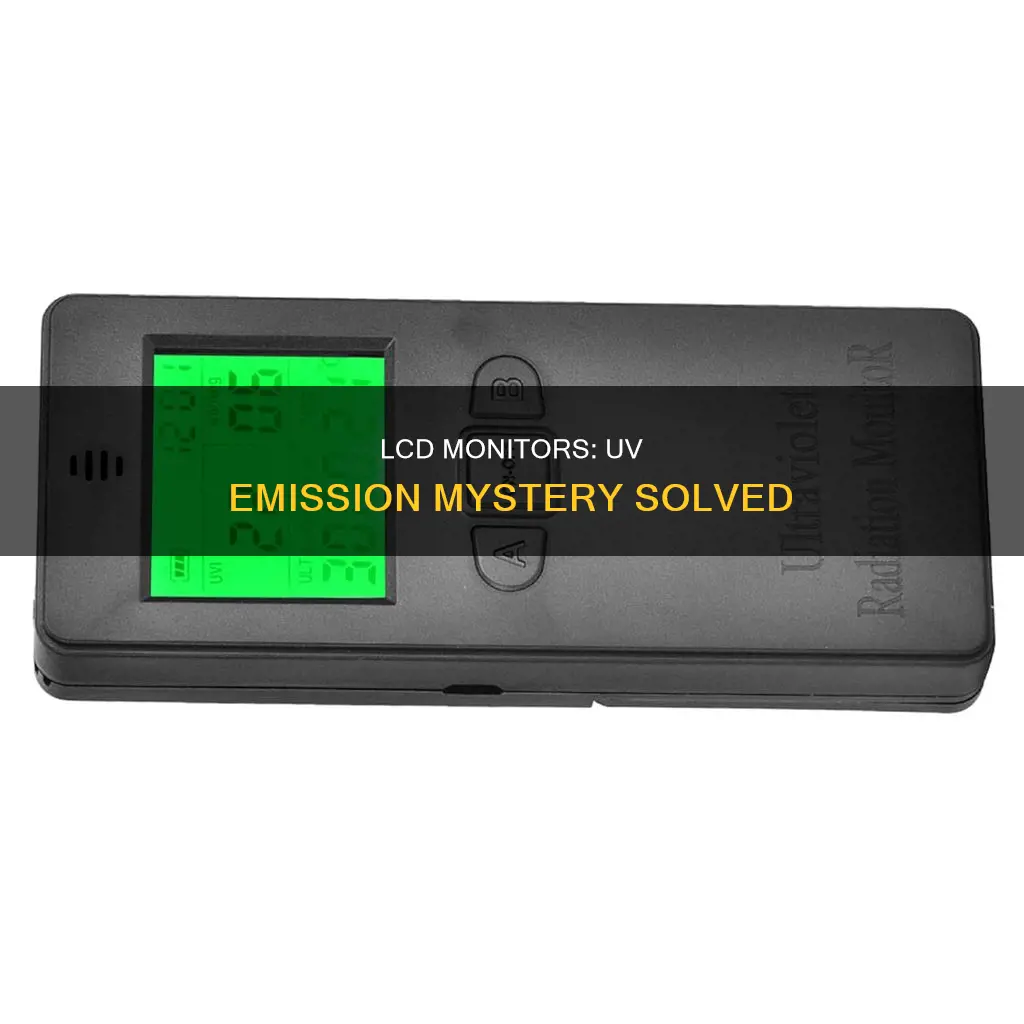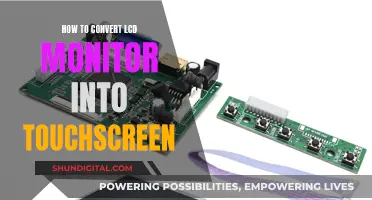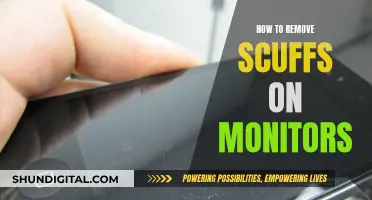
There is a lot of concern about the potential health risks of UV radiation, which can cause premature ageing, skin cancer, eye damage and immune system suppression. So, it is important to know whether the screens we spend so much time looking at emit UV radiation. The good news is that LCD screens do not emit UV radiation. However, older CRT screens do emit low levels of UV radiation, although these levels are significantly lower than that of the sun.
| Characteristics | Values |
|---|---|
| Do LCD monitors emit UV radiation? | No |
| Do CRT monitors emit UV radiation? | Yes, but in low levels |
| What are the effects of UV radiation? | Premature aging of the skin, skin cancer, damage to the eyes, suppression of the immune system |
| How to reduce eye strain? | Take frequent breaks, maintain a good distance from the monitor, follow the 20-20-20 rule |
What You'll Learn

LCD screens do not emit UV radiation
It is a common misconception that sitting in front of a computer for long hours can cause skin damage due to exposure to UV radiation. However, this notion can be put to rest as LCD screens do not emit UV radiation.
LCD, or Liquid Crystal Display, flat-panel monitors are now the most common type of screens for laptops, desktops, and mobile devices. Unlike older monitors, these newer screens do not emit any UV radiation. This means that even if you spend all day in front of your computer or staring at your phone, you are not exposing yourself to harmful UV rays.
A study published in the *Anais Brasileiros de Dermatologia* journal in 2015 also supports this claim. The study measured the emission of UVA and UVB radiation by different light sources, including LCD screens, at 5cm and 20 cm distances. The results showed no emission of ultraviolet radiation within the UVA and UVB spectra by the LCD screens, independent of the variables of type, brand, and distance.
While LCD screens do not emit UV radiation, they do emit LED light, which has been associated with eye damage. A 2013 study linked LED lights in computer screens to an increased risk of irreparable harm to the retina in the eye. The study estimated that the problem is likely to grow as more computers, mobile phones, and TV screens use LED lights.
Therefore, while LCD screens do not emit UV radiation, it is still important to take breaks from staring at screens and to maintain a good distance from the monitor to reduce the risk of eye strain and fatigue.
Internet Privacy: Government Surveillance and Online Monitoring
You may want to see also

Older monitors emit low levels of UV radiation
The good news is that newer flat-panel LCD screens, which are now commonly found on laptops, desktops, and mobile devices, do not emit any UV radiation. This means that even if you spend all day in front of a computer, you don't have to worry about UV exposure from your screen. However, it's important to note that all types of computer monitors and televisions have been found to emit blue light, which has been linked to eye damage and can interfere with sleep. To reduce the potential harm from blue light, it's recommended to stop using electronic devices at least an hour before bedtime and to maintain a good distance from the screen.
While UV radiation is no longer a concern with modern LCD screens, eye strain, fatigue, and sleeplessness can still occur from overexposure. To reduce eye strain, experts recommend following the 20-20-20 rule: every 20 minutes, look away from your computer and focus on something at least 20 feet away for at least 20 seconds. Additionally, taking frequent breaks, adjusting your workspace to avoid looking down at the screen, and using an anti-glare screen can help reduce eye strain and improve overall eye health.
In summary, while older monitors did emit low levels of UV radiation, modern LCD screens do not. However, it's important to be mindful of the potential effects of blue light and to take steps to reduce eye strain when using any type of electronic device.
Monitoring Data Usage on Android: Tips and Tricks
You may want to see also

Blue light from screens can cause eye damage
It is a common misconception that LCD screens emit UV radiation. In fact, LCD screens do not emit UV radiation. However, they do emit blue light, which has been linked to eye damage and sleep disruption. Blue light is a type of high-energy visible light with a wavelength between 400 and 450 nanometers, and it is emitted by the sun as well as digital screens and LED lights.
While blue light from electronic devices is not harmful to the retina or any other part of the eye, it can cause eye strain and sleep disturbances. Blue light has been linked to digital eyestrain, or computer vision syndrome, which affects about 50% of computer users. Symptoms include dry, irritated eyes, blurred vision, and fatigued facial muscles from squinting. To reduce digital eyestrain, experts recommend following the 20/20/20 rule, which involves looking away from your computer every 20 minutes to focus on something at least 20 feet away for at least 20 seconds.
In addition to eye strain, blue light can also interfere with your sleep-wake cycle. Blue light signals your brain to wake up, even when it should be winding down for sleep. A small 2015 study found that exposure to blue light in the evening delayed or disrupted sleep cycles by suppressing the release of melatonin, the sleep-inducing hormone. To mitigate this issue, it is recommended to stop using digital devices at least one to three hours before bedtime and to use the night shift setting on your screens to reduce blue light exposure.
While there is no strong evidence that blue light causes eye damage, some experts believe that prolonged exposure to blue light from digital screens and devices may be harmful to humans. Animal studies have shown that blue light can damage cells in the retina, but there is little proof of this in human eyes. Additionally, a 2013 study linked LED lights in consumer electronics to an increased risk of irreparable harm to the retina. However, other sources claim that the current evidence does not support the use of blue light-blocking lenses to protect eye health, and advertisers have been fined for misleading claims about these lenses.
Overall, while blue light from screens is not likely to cause eye damage, it can lead to eye strain and sleep disturbances. To reduce these negative effects, it is important to take frequent breaks from screen time and to limit device use before bedtime.
Monitoring Data Usage: Strategies for Effective Data Management
You may want to see also

Screen dermatitis can be caused by excessive exposure to light and electromagnetic fields
LCD screens, such as those found on laptops, desktops, and mobile devices, do not emit UV radiation. However, older monitors known as Cathode Ray Tube (CRT) screens emit low levels of UV radiation.
While LCD screens do not emit UV radiation, prolonged exposure to screens in general may still lead to skin problems. According to Olle Johansson, a Swedish associate professor at the Experimental Dermatology Unit of the Karolinska Institute, excessive screen exposure can lead to "screen dermatitis," where skin cells suffer due to consistent exposure to light and electromagnetic fields. Recent research also suggests that prolonged exposure to a computer screen may lead to skin discolouration, blotches, rashes, and skin allergies.
Symptoms of screen dermatitis include dermatological symptoms such as redness, tingling, and burning sensations, as well as neurasthenic and vegetative symptoms such as fatigue, tiredness, concentration difficulties, dizziness, nausea, heart palpitations, and digestive disturbances.
To protect yourself from screen dermatitis, it is recommended to take frequent breaks, get up and walk around, stretch your neck, and adjust your working space so you're not always looking down at the screen. Additionally, maintaining a good distance from the monitor, using an anti-glare screen, and wearing sunscreen can also help reduce the potential impact on your skin.
Monitoring Bandwidth Usage: Strategies for Effective Network Management
You may want to see also

Fluorescent light bulbs emit UV radiation
LCD screens do not emit UV radiation. However, older monitors such as the Cathode Ray Tube (CRT) screens used for computer monitors and TV sets emit low levels of UV radiation. These levels are significantly lower than that of the sun, and even lower than the fluorescent light bulb, which emits more UV light than a CRT monitor.
The Australian Radiation Protection and Nuclear Safety Agency (ARPANSA) has stated that the UV emissions from most indoor light sources, including fluorescent lights, are below the approved Australian limits and do not pose a risk to human health when used properly. The emissions from all sources of light decrease rapidly with distance. At a typical use distance of more than 25 cm, the UV light emitted from fluorescent lights is considered safe for healthy individuals.
The only exception is for individuals with a medical condition that makes them particularly sensitive to UV light. For these individuals, it is recommended to ensure that fluorescent bulbs have plastic diffusers over them. The plastic diffuser, along with the glass and coating inside the bulb, acts as a UV filter, further reducing the already low levels of UV radiation emitted by fluorescent light bulbs.
Choosing the Right LCD Monitor: Understanding Screen Sizes
You may want to see also
Frequently asked questions
No, LCD screens do not emit UV radiation.
Older monitors, such as CRT screens, emit low levels of UV radiation, but these levels are significantly lower than that of the sun.
Chronic exposure to UV rays can cause premature ageing of the skin, skin cancer, damage to the eyes including cataracts, and can even suppress your immune system.
As LCD screens do not emit UV radiation, there is no need to take protective measures when using these screens. However, it is recommended to take frequent breaks when sitting in front of a screen for long periods of time to reduce eye strain.







